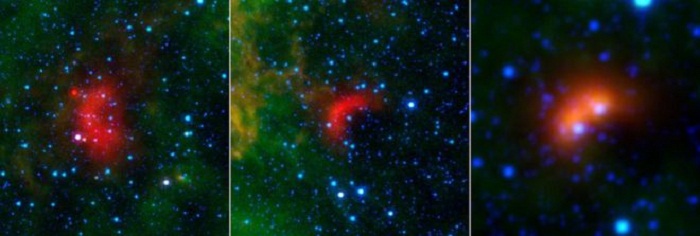Bow waves betray dozens of runaway stars

As they travel, material piles up in front of them, warms up and glows.
The team found that these bow waves make a useful signpost for spotting such speedy stars.
Their findings, presented at the 227th meeting of the American Astronomical Society in Florida, were based on survey images taken by Wise and Spitzer, two infra-red telescopes launched into orbit in the 2000s.
Breaking the Milky Way into one-degree squares, a large team of astronomers scoured these surveys for characteristic curvy red clouds. So far their search has spanned about one-third of the Milky Way`s length and turned up more than 200 candidate "bow shocks".
They then chose 80 of those candidates to study in more detail using WIRO, a 2.3m infra-red telescope in Wyoming.
"We took a look at our arc-shaped objects and tried to find stars present in the centre of each image," said William Chick, a PhD student at the University of Wyoming.
"We were surprised to discover that over 95% of these stars were in fact hot massive stars, as we`d predicted."
Some of those were stars known from previous observations to be runaways - but many were not.
"These nebulae are probably tracing runaway stars we`ve never seen before, as well as giving us laboratories in which to discover what`s creating these runaway stars, and how they evolve," Mr Chick said.
"It may be that our Milky Way is in fact swarming with these hot, runaway stars."
In fact, one of the new runaway candidates, apparently ploughing a supersonic wave of gas through our galaxy, is a binary star.
This is a very unusual observation and poses the intriguing question of what sort of force could propel twin stars violently through space, without pulling them apart.
Much about these runaways remains a mystery, Mr Chick explained; it is only thanks to infra-red surveys like those from Wise and Spitzer that the speedsters can now be picked out across the sky.
"We`re getting to the point where we can find these objects reliably, and not have to rely on the most nearby, the brightest - such as Zeta Ophiuci," he said, referring to a well-studied runaway star discovered in the 1970s.
As well as extending their search across the rest of the Milky Way, Mr Chick and his colleagues hope to study some of their fresh discoveries in more detail.
For example, measuring how fast these stars are losing mass, in the very same solar winds that create the bow waves, will help illuminate their ultimate fate: whether they will explode as supernovae or collapse as black holes.
Their precise origins are also unknown, although astronomers have two likely explanations. Either a runaway starts life as a binary star but gets blown off-course when its partner explodes, or it simply gets flung into the distance by gravitational forces in a crowded stellar neighbourhood - perhaps even a slingshot around a black hole.
The team behind the new results hopes that having many more runaway subjects to study will help tease these possibilities apart.















































